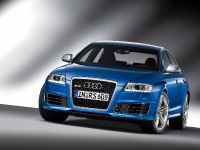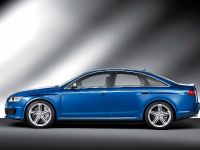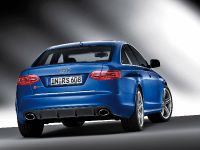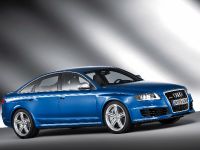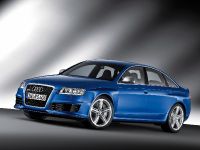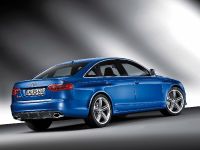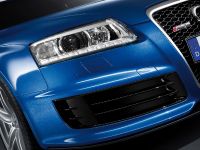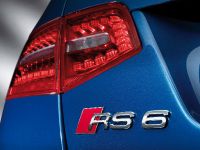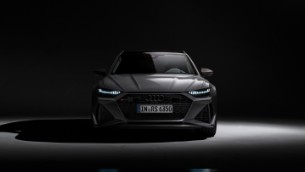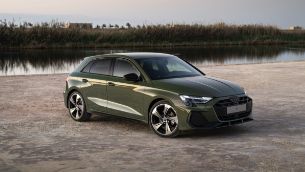The new Audi RS 6
426 kW (580 hp) and 650 Nm (479.42 lb-ft) torque, acceleration from zero to 100 km/h (62.14 mph) in 4.5 seconds and an optional top speed of 280 km/h (173.98 mph): the new Audi RS 6 Sedan has launched itself to the very top of the business class – as the most powerful series-production sedan in its segment. The sporty tiptronic transmission and the quattro all-wheel drive system, which has a slightly rear-driven emphasis, transfer the immense power onto the road with no loss. Uncompromising performance is also provided by the suspension with Dynamic Ride Control (DRC) damper control and the mighty brakes. Like all RS models from quattro GmbH, the new RS 6 is a car of supreme dynamism that makes no compromise in its qualities for everyday use.
The engine
High performance in the business class – the new RS 6, together with its sister, the RS 6 Avant, is the most powerful series-production Audi ever. With an output of 426 kW (580 hp) and 650 Nm (479.42 lb-ft) of torque, it easily beats its competitors. The V10, which generates its output from 4,991 cc of displacement, is based on the engines fitted in the Audi S6 and S8, but it has been newly developed in virtually every detail. It is a conglomeration of glorious technologies that are taken directly from the world of motor sports – the ten-cylinder concept, FSI gasoline direct injection, the twin turbochargers and the dry-sump lubrication.
The two turbochargers – one for each cylinder bank – provide for extremely powerful, homogenous thrust, which is available across almost the entire engine speed range. The peak torque of 650 Nm (479.42 lb-ft) is available across a broad and high range from 1,500 to 6,250 rpm, while maximum output is generated in the range from 6,250 rpm to the maximum engine speed of 6,700 rpm.
The V10 biturbo engine gives a performance on a par with a high-performance sports car. It sprints from a standstill to 100 km/h (62.14 mph) in 4.5 seconds. After 14.5 seconds it breaks through the 200 km/h (124.27 mph) barrier. Not until a speed of 250 km/h (155.34 mph) has been reached is the acceleration ended by the electronic limiter – although Audi will raise this top speed on request to 280 km/h (173.98 mph). The power-to-weight ratio of the new RS 6 is also comparable to a high-performance sports car at just 3.4 kilograms (7.50 lb) per horsepower.
The ten-cylinder engine is a fascinating unit. Hanging closely and excitingly on the throttle, it spontaneously converts even the slightest pedal movement into powerful forward propulsion. The V10 is highly refined. When it is accelerating, its dual-branch exhaust system with its large oval tailpipes produces a striking, sporty sound that perfectly rounds out the profile of the RS 6 high-performance sedan.
The V10: The epitome of a sports car engine
A ten-cylinder engine is the ideal engine for maximum dynamism. Compared to a V8 unit with the same displacement, the V10 has shorter and lighter connecting rods, which give it refinement at high revs. On the other hand, it has fewer components than a comparable V12 engine, giving it a lower moving mass and lower internal friction. And it is far lighter and more compact in its construction – with all its ancillaries, the V10 is a mere 670 millimeters (26.38 in) long, 790 millimeters (31.10 in) wide and 655 millimeters (25.79 in) high. The basic engine block has a length of just 560 millimeters (22.05 in).
The V10 belongs to Audi's family of V engines, all of which have a 90 degree cylinder angle and 90 millimeters (3.54 in) cylinder spacing. The two banks are offset by 18.5 millimeters (0.73 in). The bore is 84.5 millimeters (3.33 in), the stroke 89.0 millimeters (3.50 in). The crankcase is especially complex in its construction. It is produced from over-eutectic aluminum alloy using the lowpressure die-casting method. This is a material that combines low weight with very high strength. The cylinder lines are honed by extracting the hard silicon crystals from the material. The complete engine weighs just 278 kilograms (612.89 lb).
An intermediate frame – a bedplate construction – gives the crankcase maximum torsional rigidity and further improves its vibrational characteristics. This incorporates bearing brackets made of gray cast iron. These reduce the expansion of the aluminum housing due to heat and keep the play in the main bearings of the crankshaft within tight limits. The configuration of the crankcase, with cross-flow cooling and without ventilation cross-sections between the crank chambers, boosts output and increases fuel efficiency.
The forged crankshaft with common pin – a crank pin spanning the full length – increases strength while reducing weight. The same thing applies to the highstrength connecting rods made of forged steel. The pistons, which bear newly developed ring packs, are cast from an aluminum alloy.
In order to satisfy the maximum demands with respect to driving dynamics, the oil supply for the V10 comes from a dry sump, a feature that is typical in motor sports. The external oil reservoir and the pump module, which operates with varying suction levels for the sake of efficiency, are extremely sophisticated in their configuration. This ensures that all components, including the two turbochargers, are reliably lubricated at all times – even during extreme lateral acceleration exceeding 1.2 g, which the new RS 6 is capable of.
Four adjustable camshafts: the valve drive
A hydraulic mechanism is used to allow all four camshafts to be continually adjusted by up to 42 crankshaft degrees to vary the valve overlap – improving charge level and combustion. The camshafts, the oil pump module and the ancillaries are driven via maintenance-free chains, which are located at the rear of the engine. The valves, which are actuated by roller cam followers with hydraulic valve-play compensation, have a diameter of 33.9 millimeters (1.33 in) on the inlet side and 28.0 millimeters (1.10 in) on the exhaust side. The exhaust valves, which are subjected to very high thermal loads, are filled with sodium for better cooling.
Like most of Audi's gasoline engines, the V10 in the new RS 6 also employs the FSI gasoline direct injection system. A common rail system – another standard for the brand – injects the fuel into the combustion chambers with a pressure of up to 120 bar.
Vacuum-controlled charge-movement flaps in the flange of the intake manifold, which is made of pressure-cast aluminum, set the drawn-in air into a "tumble" at up to 3,500 rpm. This rotational movement vertical to the cylinder axis improves combustion efficiency.
FSI is combined with turbochargers to make TFSI – both technologies harmonize perfectly. The swirl of the fuel draws heat from the walls of the combustion chambers, which resolves the old problem of turbocharger technology: excessive heat development. At 10.5:1, the compression ratio of the V10 in the new RS 6 is greater than in most naturally aspirated engines. This results in highly efficient combustion. The V10 biturbo consumes on average 13.9 liters of fuel per 100 km (16.92 US mpg) – a very respectable figure considering the potency of the vehicle. In motor sports, Audi's TFSI technology has enjoyed an astounding series of victories. It has powered the R8 racing car to five overall victories in the Le Mans 24 Hours and to 63 other successes in 80 starts.
In the new Audi RS 6, the V10 TFSI is controlled by an advanced Motronic engine management system with the designation MED 9.1.2. This works with ten single-core ignition coils and two control units operating according to the masterslave concept. Here, for the first time in this class, the load is monitored using a pressure sensor in the intake manifold. Two primary and two main catalytic converters assume the task of cleaning the exhaust gases. Because they are located close to the engine, they reach their operating temperature, and thus their full efficiency, very quickly after the engine is started.
The two large turbochargers are also high-performance components. They build up a charge pressure of up to 0.7 bar. At full load they are theoretically able to compress up to 2,200 cubic meters (77,692.26 cu ft) of air per hour. The chargers, and the complete air ducting, are optimized for a spontaneous, practically lag-free response. Air flows to the two large intercoolers, which reduce the temperature of the compressed air, through large inlet openings in the front apron.
Powertrain
The superior output of 426 kW (580 hp) requires a powertrain that is just as potent. On the new Audi RS 6, a sportily configured six-speed tiptronic transmission feeds the torque to the quattro permanent all-wheel drive system, which is also configured for maximum dynamism.
The tiptronic six-speed automatic transmission is one of the new generation of transmission units that is currently being introduced to the Audi model range. Its extremely compact and lightweight layout means that it harmonizes perfectly with the dynamic character of the new RS 6. Its torque converter usually works with the lockup clutch closed. The electronic transmission management system, which orientates itself toward the driver's style, has been optimized with new, powerful software that links it directly to the engine.
Improved routing of the oil ducts makes the gearshifts even faster. The response time has been cut to one tenth of a second and the gearshift time has been halved – shifting down with kickdown now takes less than a second. The transmission ratios have been systematically shortened. When the throttle is opened, the most powerful series-production Audi ever can still pick up speed impressively even in sixth gear.
The driver can select sport mode ("S") at the selector lever. The tiptronic then executes upshifts later, and the gears can also be changed manually, either with the selector lever or with the shift paddles. The aluminum-look shift paddles are located on the back of the steering wheel rim and are turned along with the wheel.
Grip and safety: the quattro drive system
The new Audi RS 6 also transfers its power to the road via the quattro permanent all-wheel drive system – the superior traction and the greater sense of driving enjoyment that it conveys are classic strengths of the brand. The quattro drive system is another winning technology that Audi has taken from motor sports. Its current generation with asymmetric/dynamic torque distribution highlights yet again the philosophy behind the brand motto "Vorsprung durch Technik".
A Torsen center differential (Torsen = torque-sensing), located longitudinally in the drive train, distributes the torque to the front and rear axle. In normal situations, 40 percent of the force is fed to the front axle and 60 percent to the rear – a slightly rear-driven emphasis. This further underscores the dynamism of the RS 6.
If road conditions change, for example if a wheel moves onto slippery asphalt, the differential, which works on a purely mechanical basis, instantaneously changes the distribution in favor of the axle with the better traction. It is possible for up to 85 percent of the force to be fed to the rear axle and up to 65 percent to the front axle. If one wheel on an axle should start to spin, it is braked by the electronic differential lock (EDL). However, this situation is very rare.
For the driver, quattro permanent all-wheel drive means maximum agility, extremely stable handling and uncompromising grip at the end of the bend, even on wet roads, while the competitors look on helplessly with their two driven wheels. The relatively low weight of the engine means a well balanced distribution of the axle loads. The battery and energy management system are accommodated in the luggage compartment, which supports this effect even further.
Suspension
You cannot afford to have weaknesses if you want to dominate the competition. This motto also bears true for the suspension of the new RS 6. The advanced suspension, the high-tech Dynamic Ride Control (DRC) damping system and the mighty braking system form a package that perfectly controls the enormous power of the drive system. The suspension of the new RS 6 combines a high standard of long-distance comfort and relaxed straight-line driving with impressive performance. Dynamic steering characteristics, an exact response, uncompromising precision and supreme stability forge links between the race circuit and the freeway.
Most of the wheel suspension components are made of lightweight aluminum – a construction style that reduces unsprung masses and gives the handling a reflexlike spontaneity. On the front axle, each wheel is guided by four aluminum links. The elastokinematics have been configured to be especially dynamic.
The track width is an impressive 1,614 millimeters (63.54 in). The trackcontrolled trapezoidal link rear axle even has a track width of 1,637 millimeters (64.45 in). Here, the kinematics have also been modified in favor of sportiness.
The maps of the servotronic speed-dependent steering system have also been reconfigured. The steering gear has a dynamic and direct transmission ratio of 12.5:1. With its sensitive workings, the steering links the driver closely and precisely with the road.
The new Audi RS 6 assumes an unrivaled position on the global sedan market. A major factor in this is the Dynamic Ride Control (DRC), fitted as standard, a similar form of which was also found in the predecessor model. The advanced DRC reduces pitching and rolling movements around the lateral and longitudinal axes. It is purely mechanical in its operation and so completely lag-free. It is compact and lightweight in its construction.
The operating principle of the DRC is simple. The diagonally opposite shock absorbers are linked by two oil lines and a central valve. If the RS 6 takes a corner at high speed, the valves react instantaneously to the oil flow at the compressed shock absorber for the front wheel on the outside of the bend. They strengthen the support provided, reduce lateral tilt and so increase dynamism.
If requested, Dynamic Ride Control (DRC) can be supplemented by three-stage variable damping characteristics. The so-called sports suspension plus allows the driver to customize his driving experience at the MMI control terminal according to the route profile and his own wants and desires. In the "comfort" setting, the sports suspension plus provides for a good level of ride comfort. The "dynamic" mode allows a highly active driving style, while "sport" mode provides for maximum driving precision.
Fun and stability: ESP
The electronic stabilization program (ESP) rounds off the dynamic performance. It only intervenes at a very late point to provide maximum driving enjoyment with full driving safety. The driver selects sport mode by briefly pressing a button. Engine intervention – ASR, a subfunction of ESP – is then largely deactivated, and brake intervention is triggered at a later point.
This enables expert drivers to execute superb drifts in the new RS 6 on road surfaces with a very low coefficient of friction. Furthermore, this setting helps when pulling away in deep snow. Both functions can be fully deactivated by pressing and holding the ESP button.
The new Audi RS 6 runs on cast alloy wheels of 10-spoke design and of size 9 J x 19. Size 255/40 R 19 tires are fitted, and these are monitored as standard by an indirect, maintenance-free tire pressure monitoring system. On request, Audi will supply the RS 6 on 20-inch cast wheels in size 9.5 J x 20. These are of 5 segment-spoke design and available in either aluminum or titanium look. Alternatively, there are also cast aluminum wheels of 7 twin-spoke design available in the same size. The tires are of the thoroughly impressive 275/35 R 20 format and also feature a pressure monitoring system.
For any exceptional athlete, slowing down is at least as important as sprinting ability. The new Audi RS 6 is equipped with a high-performance brake system that is built to withstand extreme loads. Even the standard steel disks are designed to withstand maximum loads. Their aluminum brake disk chamber is linked to the cast iron friction ring with metal pins – a floating mount that boosts performance at high loads while reducing weight. The cooling ducts and the axial perforation of the disks fulfill the same tasks.
The front brake disks have a diameter of 390 millimeters (15.35 in) and are actuated by fixed six-piston aluminum calipers. The rear disks have a diameter of 365 millimeters (14.37 in) and single-piston floating calipers. The calipers are painted black and adorned with the RS logo at the front.
In conjunction with the 20-inch wheels, Audi can also fit a ceramic brake system. This also has ventilated and perforated disks that are made from a composite material in which high-strength carbon fibers are embedded in hard, abrasionresistant silicon carbide. They have an impressive diameter of 420 millimeters (16.54 in) at the front and 356 millimeters (14.02 in) at the rear, yet they weigh 12.2 kilograms (26.90 lb) less than the steel disks, reducing unsprung masses in favor of driving dynamics.
The ceramic brakes give an uncompromising performance. They withstand the most extreme loads without any problem, remain free of corrosion and as a rule achieve a service life covering some 300,000 km (190,000 miles). The brake calipers – with eight pistons at the front – are painted in anthracite and bear the lettering "Audi ceramic" at the front.
Design
Dynamic elegance – the design of the new Audi RS 6 is characteristic for an Audi. The high-performance V10 engine and its two turbochargers need a lot of air to breath and for cooling, so the inlet openings in the front had to be enlarged accordingly. They are surrounded by arched bridges. The front apron has also been redrawn. Within the single-frame radiator grille, there is a high-gloss black protective grille in a hexagonal, honeycomb design bearing the red and silver RS 6 logo.
Next to the xenon plus headlights, which can optionally be complemented with the dynamic cornering light function known as adaptive light, are the front fog lights, which have been relocated to allow a greater throughput of air in the front apron. The daytime running lights strips, each comprising ten LEDs on the lower edge of the headlight, provide a powerful visual touch. A cover on the top of the headlight focuses this view.
Powerful side trims and flared fenders are the main features of the side view. To reduce weight, the front fenders are made of aluminum, as is the hood. These create space for the large wheels of the new RS 6. At the same time, they are reminiscent of a milestone in the history of the automobile, the original 1980 Audi quattro ("Ur-quattro"), the pioneer of permanent all-wheel drive.
This powerful look is continued at the rear of the vehicle. The broad diffuser with its own special look, holding a large oval exhaust tail pipe on both the left and the right-hand sides. A rear spoiler harmoniously integrated into the side panels and the trunk lid is aerodynamically extremely effective, and the RS6 emblem rounds off the fine detail. The rear lights predominantly employ LED technology.
The new Audi RS 6 has a length of 4,928 millimeters (16.17 ft), a wheelbase of 2,846 millimeters (9.34 ft), a width of 1,889 millimeters (6.20 ft) and a height of 1,456 millimeters (4.78 ft). The drag coefficient is 0.31. The distinct elegance of the design is underlined by the standard metallic/pearl effect paint. The color Sepang Blue is exclusively reserved for the RS 6. Other colors that are available are Monza Silver, Monterrey Green, Phantom Black, Mugello Blue, Misano Red and Daytona Gray.
Interior
The interior of the new RS 6 is an oasis of wellness. High-grade materials such as carbon fiber, aluminum, leather and Alcantara have been selected and employed with the uncompromising, immaculate quality for which Audi and quattro GmbH are renowned. They create an ambience of cultivated dynamism and form an elegant dress for the high-tech package that can be found underneath.
A standard feature of the new RS 6 is a very special steering wheel – the leathercovered RS multifunction sport steering wheel. Its rim, which can optionally be trimmed in full-grain leather, is particularly substantial and is flat-bottomed, like on a racing car. The spokes incorporate multifunction buttons for operating the telephone, navigation system and audio system. Shift paddles for the tiptronic transmission allow fast manual gear changes, while an RS 6 signet provides a visual highlight. Audi is also able to fit the leather-covered multifunction sport steering wheel of three-spoke design with all-round rim at no extra cost.
As on every Audi, the instruments on the new RS 6 are clearly and brightly drawn. They are supplemented by an indicator showing the charge pressure of the turbochargers. This can be called up on the driver information system, as can an oil temperature display and a lap timer. Its display and the monitor of the MMI operating and multimedia system show the RS 6 logo when the ignition is switched on. The deluxe automatic air conditioning plus allows the interior to be heated or cooled in two separate zones.
The inlays in the new Audi RS 6 are made of carbon fiber and are precisely framed by narrow aluminum strips, and carbon fiber composite is also used for the center tunnel trim. Alternatively there are the versions Matt brushed aluminum, Fine grain myrtle nutmeg and Piano finish black. The cockpit front panel, which houses the instruments and display, is always in an extremely elegant black piano finish.
The control buttons for the MMI terminal, and the sports pedals and footrest feature the aluminum look. On the sills are sill strips with aluminum inlays bearing the RS 6 logo. The headlining and the insides of the posts can optionally be dressed in high-tech Nardia fiber. The door openers are specially shaped.
Strong support: The sports seats
The prominent shape of the sports seats gives the body the best possible support. They are electrically adjusted and incorporate an integral head restraint and manually adjustable thigh support. The sports seats have Silk Nappa leather upholstery with embossed RS 6 logo. Alternatively they are also available with Valcona leather. Contrasting stitching is included in both cases. Moreover, there is also a leather/Alcantara combination available as seat upholstery. The two front seats and the two outer seats in the rear are heated as standard. As an alternative for uncompromising sportiness, Audi can also fit RS bucket seats.
The new Audi RS 6 offers plenty of space for five passengers and their luggage. There remains a comfortable amount of space for the head, arms and legs, even on the rear bench seat. The trunk has a volume of 546 liters (19.28 cu ft), and can be increased if needed by folding the rear seat backrests forward. Another option is a trunk lid that automatically opens after it has been unlocked.
Equipment
The new RS 6, which will be in German showrooms from mid-October priced 105,550 euros, is fitted with standard equipment that underlines its dynamic, exclusive character. From the outside, Audi's most powerful series-production sedan can be recognized by a whole series of exclusive features – for example the LED daytime running lights, the flared fenders and the 19-inch cast aluminum wheels. The tires are continually monitored to ensure that they have the correct pressure. Metallic/pearl effect paint underlines the sporty, elegant lines.
On the inside, the new RS 6 has electrically adjustable sports seats with Silk Nappa leather upholstery. The front and outer rear seats can be heated. Carbon inlays, a cockpit front panel in piano finish and RS 6 logos are visual highlights in the interior. Safety and comfort are also of the very highest standards. An automatic anti-dazzle interior mirror, a leather-covered RS multifunction sports steering wheel with shift paddles and the deluxe automatic air conditioning plus provide a sense of luxury.
An alarm system and six airbags – two front, two side and two head airbags – enhance safety. ISOFIX mountings enable child seats to be fitted quickly and reliably in the rear. A key equipment feature is the parking aid known as Audi parking system plus – eight ultrasonic sensors transmit signals that are optically and acoustically processed with very high precision.
For the dedicated individualists among the RS 6 customers, the options represent the very pinnacle of what is technologically feasible. The sports suspension plus allows the driver to adjust the damping, which is already highly precise thanks to Dynamic Ride Control technology, in three maps. The 20-inch aluminum wheels are fitted with size 275/35 tires, and behind them there is space for a highperformance brake system with powerful ceramic disks. The options also include raising the top speed to 280 km/h (173.98 mph).
For the seats, Audi offers Valcona leather with contrasting stitching and a leather/Alcantara combination. The adaptive light system, which dynamically illuminates bends in the road, helps the driver to stay relaxed.
Audi's intelligent high-tech assistance systems make driving even easier. Audi lane assist makes it easier to stay in lane. If the driver approaches a lane marking without activating the turn signal, the system will warn him by vibrating the steering wheel. Audi side assist monitors the area to the rear of the new RS 6. When changing lanes, it warns of a potentially critical situation with a bright yellow LED in the exterior mirror.
The adaptive cruise control (ACC) system is another ultra-modern assistance system. It maintains a set speed between 30 and 200 km/h (18.64 – 124.27 mph), depending on the speed of the vehicle in front. The system accelerates and brakes gently as necessary. Working in two stages, the integrated braking guard function cuts in to prompt the driver to apply the brakes in dangerous situations.
MMI – the new high-end multimedia system
In the field of multimedia, the Audi RS 6 has another high-end solution on board – the new third-generation MMI operating and multimedia system. Its intuitively understandable, strictly logical operating concept with a large terminal on the center tunnel has remained unchanged, giving it a decisive edge over the competition. The color monitor with its 6.5-inch or 7-inch screen is positioned high up in the instrument panel where it can easily be seen.
The Bose Surround Sound system is standard in the new RS 6. It generates its powerful, clear sound pattern with a 270 watt amplifier and 13 speakers. Its algorithm analyzes driving and exterior noises and adjusts its frequency response accordingly to compensate. A six-disk CD changer comes as standard with the system.
On request, RS 6 customers can also order the new MMI navigation plus. The user is treated to a dazzling array of functions – a three-dimensional road map, a drive for navigation, audio and video DVDs, a twin tuner for radio reception and full-word voice input for the telephone book, which can store up to 2,000 entries, each with five numbers.
Like the navigation data and the Owner's Manual, the telephone book entries are stored on a hard drive with a memory capacity of 40 GB. This can also be used as a jukebox, perfectly recording and sorting up to 4,000 music tracks. This version of the MMI also incorporates a large, extremely high-resolution display with a brilliantly bright image. The central control knob incorporates a cap-shaped joystick, which makes operation even easier.
Optional technical modules make the MMI even more attractive. The Audi music interface perfectly integrates external MP3 players, for example the customer's iPod. Another highlight is DAB digital radio reception (Digital Audio Broadcasting), which is qualitatively far superior to the analog standard. A TV tuner for analog and digital reception (DVB-T) is also available.
On request, maximum convenience can even be provided making a phone call. The Audi Bluetooth car phone integrates the customer's cell phone via a Bluetooth chip, providing it supports the SIM access profile. The car phone is activated whenever the ignition key is in the lock. It takes the data from the SIM card and from the memory in the cell phone, and then switches the cell phone off completely.
For 14 years: the line of uncompromising dynamism
The RS models have been at the top of the Audi range since 1994. In the upper midsize class, the RS 2 and RS 4 defined the standards in terms of power and performance, in the full-size class the RS 6 advanced into a new dimension. All RS models combine emotion and perfection to form a fascinating overall concept.
The Audi RS 2 was the result of a cooperation with Porsche in 1994. Its fivecylinder turbocharged engine with four-valve technology generated an output of 232 kW (315 hp), which the quattro drive transformed superbly into forward propulsion. Its performance placed it in the league of powerful sports cars, as did its brake system. With the RS 2, Audi created a concept that was picked up and continued by the first Audi RS 4 in 2000. This was powered by a 2.7-liter V6 engine with twin turbochargers, generating 279 kW (380 hp).
The Audi RS 4 presented in 2005 followed another technical path – using a naturally aspirated, high-revving V8 engine. FSI gasoline direct injection enabled the 4.2-liter engine to generate 309 kW (420 hp). Its torque was 430 Nm (317.15 lb-ft) at 5,500 rpm. The RS 4 was available as a sedan, Avant and convertible. Its predecessors had only been available as Avant models.
In the A6 model series, the Audi RS 6 made its debut in 2002. This model was powered by an early version of the 4.2-liter V8. Charged up with two turbochargers, the five-cylinder engine with manifold fuel injection generated 331 kW (450 hp). Audi offered the first RS 6 as a sedan and as an Avant. The pinnacle of the model range was the special limited edition RS 6 plus with 353 kW (480 hp).
